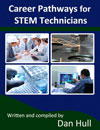OP-TEC's
Dan Hull, compiler of
Career Pathways for STEM
Technicians
ATE Central: Can you tell me a little bit about your
background in
ATE and with
the ATE
community?
Dan Hull: Well let me go way back. I'm a registered,
professional engineer. My undergraduate degree was from the
University of Texas in electrical engineering. I've got a graduate
degree from the University of Pittsburgh, and some advanced
studies from Johns Hopkins. I graduated just about a year before
lasers came out, and so I got involved very early in the beginning
of lasers and worked in this field for 14 years before I got
involved in technician education. In 1973, I was a manager of
radar and communications systems for
NASA
and I could not find good technicians—I could get engineers,
but I couldn't hire the kind of technicians I needed. So in 1974,
I agreed to take a one-year leave of absence to work on this
issue. I've been working on it ever since because I feel very
passionately that there's a three-legged stool in technical
fields: scientists, engineers, and technicians. And we don't have
enough technicians. They're the geniuses of the labs; they're the
masters of the equipment. They know how things work. But they're
not just manual laborers—these people need good math and science
backgrounds, and
ATE programs
provide that.
ATE ensures
that this is education. This is not just training.
When I decided I wanted to do something different, I had the
opportunity to create and operate
OP-TEC.
Six years ago, the center was awarded, and I was back to my roots:
this was what I wanted to do in 1974.
ATE Central: Can you tell me a little bit about this
CPST
project: how it came about, and who's involved?
Hull: Let me just tell you that our center is
representative, but we're not unique in this technician problem.
OP-TEC
conducted a 2009 needs assessment, where we went to photonics
employers and said, "How many 2-year degree technicians do you
need?" And generally speaking, we need about 1,000 new photonics
technicians every year. We have around 30 colleges that have
photonics programs. But we have less than 800 students in these 30
colleges. And we're graduating less than 300 a year. When you need
1,000 and you're graduating 300, you're asking, What am I going to
be able to do about this?
You always hope you recruit some people that are 30, 35 years old
that are wanting to do a career change, but mostly you want a high
school pipeline. You want people that realized their interest 2 or
3 years earlier and got ready for it. The technicians are
typically not all A students—some of them are—but many of them are
B and C students. And frequently by the time they get to high
school the B and C students have kind of gotten the message:
You're not too smart, you can't do much. These students are
bright—they may learn differently, but they're bright. But the
high schools do not prepare for them. There just isn't a pathway
in most high schools to encourage these people to get into STEM
fields and to prepare them, and to help them to realize when they
graduate from high school that their next step is at a two-year
college.
We looked around, and last year there were over 3,000
STEM
high schools. Now there are 4,000. But they're attracting the A
students; they're attracting the students who are interested in
becoming scientists and engineers. We're not asking these schools
for big expenditures; we're asking them to have a sensitivity to
reach out—not asking them to cut back on their engineers or
scientist enrollment, but to add technician career pathways to
their programs.
ATE Central: Is there a particular reason that this
shortage is happening now? Or is it a problem that's been building
over time?
Hull: A couple of studies address that question, and
they're listed in the first chapter of the
CPST
book. A study that came out from the National Academies was one of
the ones that talked about that in detail—it was called "Rising
Above the Gathering Storm." That came out five years ago and said,
We need more technical people in the workforce. The Academies
group came back and revisited it three or four years later, and
said, We don't see much happening. If we don't—now they call it a
Category 5 storm—if something doesn't happen pretty soon, we're
going to be in deep trouble in this country. Then in February of
2011, Harvard came out with the "Pathways to Prosperity" study.
And they said nearly everybody needs some education past high
school, but we don't all need baccalaureate degrees.
I've talked to my colleagues who are running other
ATE centers,
and they're having the same problem we are. We work like crazy to
build good curriculum, to get industry support, to start programs
at colleges and so forth, but we're not turning out the numbers
that we need because we're not getting students enrolling in these
programs as fast as we need them. If we can leverage these
STEM
high schools to give us the students and prepare them, then we've
come a long way towards solving our problem.
ATE Central: In the introduction to
CPST,
you mention three solutions to this problem: first of all the
recognition of the problem, then engagement in a process to
identify students who are interested in becoming technicians, and
then a commitment to providing these career pathways.
Hull: The solution is all focused on these
STEM
high schools. The educators, the high schools, and their parents
need to recognize that these are good programs. Parents need not
to think, Well, if my student doesn't go to a university, they're
going to have a second-rate life. We talk a lot in the last
chapter of the book about how we can bring these changes about. We
made a checklist of six items each for the high school, community
college, and for the employers: what they have to do to make this
work. The worksheets document who is going to do what, and what
obstacles they might face. We're really trying to ramp up a
movement.
ATE Central: A lot of your solution seems focused on
person-to-person engagement, talking to counselors, getting
community college representatives out there, and in many ways
changing how we think about community colleges. Is that fair to
say?
Hull: We've got to change attitudes about two things. One
is we've got to change our attitude about students who are not in
the top 20% not having any value. That's crazy. Everybody wants to
believe that their kids are in the top 20% but they're not all in
there.
The second misperception is that the only path to success is a
baccalaureate degree. Our students in the photonics area are
getting anywhere from $45,000 to $60,000 a year when they go to
work. These are rewarding jobs; they're not dead-end jobs.
ATE Central: So you need to get people onboard from all
sides?
Hull: The bottom line—after we've won recognition and
we've engaged the stakeholders—is that high schools need to
make these
STEM
career pathways, and it's going to take some work. The person who
wrote the fourteenth chapter of the book—her name's Jill
Siler—was a deputy superintendent at Lake Travis high
school. They eliminated all their old vocational education
courses, and she rebuilt these career institutes. She's talked
about how they made this major change.
We lay a pretty good plan out in that fourth chapter of
CPST.
And then all the
ATE center
chapters—8 total—talk about that fourth chapter model.
The chapter authors look at that model and say: Here's how that
would play out in the photonics sphere, or here's how that would
play out in the nanotech area, or here's how that would play out
in the
MEMS area, or
here's how that would play out in biotech, or bio-manufacturing,
and so forth. So they're all examples that say: This can be done
in these different
ATE fields.
 The Institute for Food Safety
(IFS) is a
state-of-the art "co-laboratory" shared by Florida State College
at Jacksonville and Eurofins, an international fee-for-service
food testing laboratory. The two labs, academic and commercial,
work side-by-side with common spaces and equipment. This novel
partnership, with support from the business community and
government, will address the issues of a changing and growing food
safety industry.
The Institute for Food Safety
(IFS) is a
state-of-the art "co-laboratory" shared by Florida State College
at Jacksonville and Eurofins, an international fee-for-service
food testing laboratory. The two labs, academic and commercial,
work side-by-side with common spaces and equipment. This novel
partnership, with support from the business community and
government, will address the issues of a changing and growing food
safety industry.

 A few weeks ago, I received a preview of Dan Hull's newest book:
A few weeks ago, I received a preview of Dan Hull's newest book: